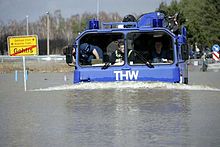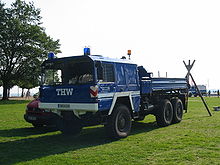Technisches Hilfswerk: Difference between revisions
m Reverted edits by 156.110.28.247 (talk) to last version by 88.217.59.191 |
No edit summary |
||
| Line 20: | Line 20: | ||
The largest action outside Germany was in [[France]] in [[2000]], when storms destroyed much of the overhead electrical overland wires and overturned trees blocked many streets. The main work was supplying temporary electrical power for the hospitals and other important institutions and rebuilding parts of the electrical system. |
The largest action outside Germany was in [[France]] in [[2000]], when storms destroyed much of the overhead electrical overland wires and overturned trees blocked many streets. The main work was supplying temporary electrical power for the hospitals and other important institutions and rebuilding parts of the electrical system. |
||
The organisation has also been active in many disaster relief operations abroad, for example after the [[2004 Indian Ocean earthquake]] (for both relief operations and medium-term rebuilding), [[Hurricane Katrina]] in 2005, and the [[2005 Kashmir earthquake]]{{ |
The organisation has also been active in many disaster relief operations abroad, for example after the [[2004 Indian Ocean earthquake]] (for both relief operations and medium-term rebuilding), [[Hurricane Katrina]] in 2005, and the [[2005 Kashmir earthquake]]<ref>{{cite web |url=http://www.thw.bund.de/cln_036/nn_942466/EN/content/news/international/missions/2005/11/news__001.html |title=Technical and Humanitarian Assistance Worldwide |accessdate=2008-04-29 |format= |work= }}</ref>. |
||
==Organisation== |
==Organisation== |
||
Revision as of 22:57, 28 April 2008
The Bundesanstalt Technisches Hilfswerk (Federal Agency for Technical Relief, THW) is a disaster relief organisation controlled by the German federal government. 99% of its members are volunteers.
Tasks

The tasks of the THW are described in a law called Helferrechtsgesetz. These tasks are:
- technical relief in Germany as part of the civil defence
- technical or humanitarian relief in foreign countries, with assignment by the government
- technical and logistical relief for other (German) GOs, NGOs or other authorities like fire brigades, police or the custom authorities.
History

After World War II the Technisches Hilfswerk was founded in 1950. The main purpose was civil defense in the event of war. This has changed during the decades; today the THW is a capable helper in a wide spectrum of disasters, such as traffic accidents, industrial disasters, or earthquakes.
The largest disaster control action took place in August 2002 after the severe flooding of the Elbe river in eastern Germany. All in all, about 24,000 THW members participated in the operation, with up to 10,000 people helping simultaneously along the Elbe and its tributaries (see 2002 European flood).
The largest action outside Germany was in France in 2000, when storms destroyed much of the overhead electrical overland wires and overturned trees blocked many streets. The main work was supplying temporary electrical power for the hospitals and other important institutions and rebuilding parts of the electrical system.
The organisation has also been active in many disaster relief operations abroad, for example after the 2004 Indian Ocean earthquake (for both relief operations and medium-term rebuilding), Hurricane Katrina in 2005, and the 2005 Kashmir earthquake[1].
Organisation
The THW is stationed all over Germany in 669 local bases, called Ortsverbände. 80,000 people work for this organisation. The majority of those are volunteers, while about 800 work full-time in the administration of the organisation. Each Ortsverband maintains one or more Technische Züge (technical platoons), each consisting of one Zugtrupp (command team), comprising four volunteers, two Bergungsgruppen comprising nine to twelve volunteers, and one to three Fachgruppen, comprising of four to eighteen volunteers.

The main type of THW unit (about two out of three) is the Bergungsgruppe (rescue and salvage squad), equipped with heavy tools like hydraulic scissors, chain saws, and pneumatic hammers.
The Fachgruppen (specialized squads) include:
- Infrastruktur (infrastructure),
- Räumen (debris clearance),
- Elektroversorgung (electric supply),
- Beleuchtung (illumination),
- Wasserschaden / Pumpen (water-damage / pumping),
- Wassergefahren (water-hazard),
- Logistik (logistics),
- Ölschaden (oil pollution),
- Trinkwasserversorgung (water supply and treatment),
- Führung und Kommunikation (technical unit command, control and communications)
- Ortung (detection)
among others.

For relief in foreign countries, there are four Schnelleinsatzeinheiten Bergung Ausland or SEEBA (rapid deployment unit search and rescue)units, able to go airborne within six hours[2], and five Schnelleinsatzeinheiten Wasserversorgung Ausland or SEEWA (rapid deployment water supply and treatment) units.
In Germany, military service is mandatory for adult males. Instead of joining the military for nine months full-time, one of the alternatives is to join a non-combatant volunteer organisation of the German Katastrophenschutz (disaster relief) or Zivilschutz (civil defense) for a minimum of six years. The THW is one of those organisations, as well as volunteer fire brigades or various organisations engaged in emergency medical service. See also conscription in Germany.
References
- THW - Homepage Official homepage, in German
- THW - Homepage English version
- Technisches Hilfswerk - German Federal Agency for Technical Relief Short summary in English (PDF file)
- ^ "Technical and Humanitarian Assistance Worldwide". Retrieved 2008-04-29.
- ^ "The SEEBA Special Unit – the Government's Tool to Help Rescue and Salvage Operations Domestically and Abroad". Retrieved 2008-02-17.
